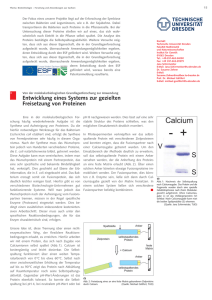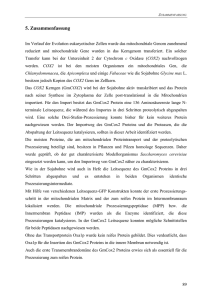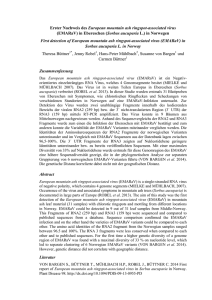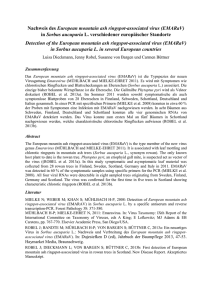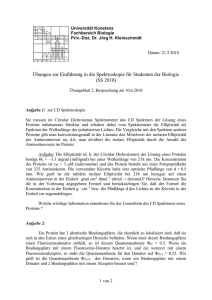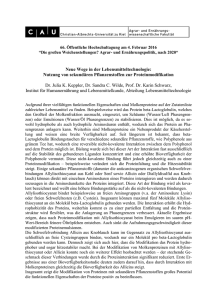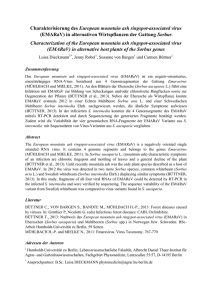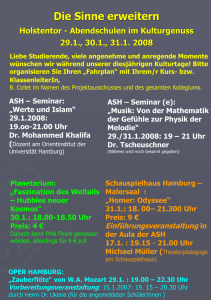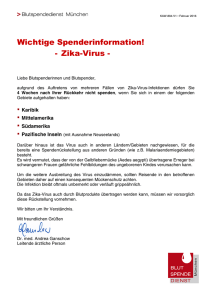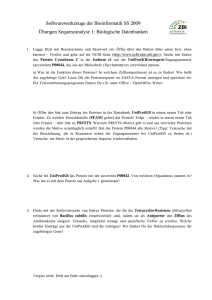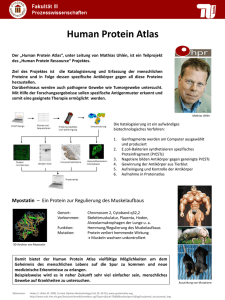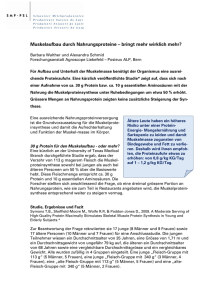Untersuchungen zur Dimerisierung der p3 und p4 Proteine des
Werbung
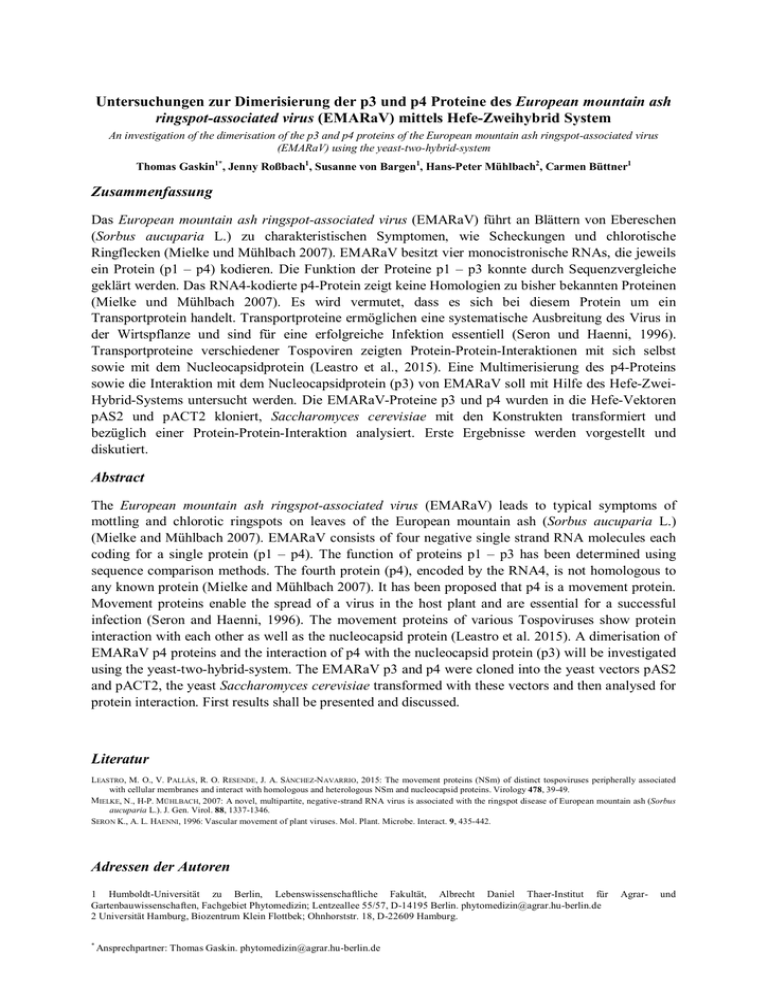
Untersuchungen zur Dimerisierung der p3 und p4 Proteine des European mountain ash ringspot-associated virus (EMARaV) mittels Hefe-Zweihybrid System An investigation of the dimerisation of the p3 and p4 proteins of the European mountain ash ringspot-associated virus (EMARaV) using the yeast-two-hybrid-system Thomas Gaskin1*, Jenny Roßbach1, Susanne von Bargen1, Hans-Peter Mühlbach2, Carmen Büttner1 Zusammenfassung Das European mountain ash ringspot-associated virus (EMARaV) führt an Blättern von Ebereschen (Sorbus aucuparia L.) zu charakteristischen Symptomen, wie Scheckungen und chlorotische Ringflecken (Mielke und Mühlbach 2007). EMARaV besitzt vier monocistronische RNAs, die jeweils ein Protein (p1 – p4) kodieren. Die Funktion der Proteine p1 – p3 konnte durch Sequenzvergleiche geklärt werden. Das RNA4-kodierte p4-Protein zeigt keine Homologien zu bisher bekannten Proteinen (Mielke und Mühlbach 2007). Es wird vermutet, dass es sich bei diesem Protein um ein Transportprotein handelt. Transportproteine ermöglichen eine systematische Ausbreitung des Virus in der Wirtspflanze und sind für eine erfolgreiche Infektion essentiell (Seron und Haenni, 1996). Transportproteine verschiedener Tospoviren zeigten Protein-Protein-Interaktionen mit sich selbst sowie mit dem Nucleocapsidprotein (Leastro et al., 2015). Eine Multimerisierung des p4-Proteins sowie die Interaktion mit dem Nucleocapsidprotein (p3) von EMARaV soll mit Hilfe des Hefe-ZweiHybrid-Systems untersucht werden. Die EMARaV-Proteine p3 und p4 wurden in die Hefe-Vektoren pAS2 und pACT2 kloniert, Saccharomyces cerevisiae mit den Konstrukten transformiert und bezüglich einer Protein-Protein-Interaktion analysiert. Erste Ergebnisse werden vorgestellt und diskutiert. Abstract The European mountain ash ringspot-associated virus (EMARaV) leads to typical symptoms of mottling and chlorotic ringspots on leaves of the European mountain ash (Sorbus aucuparia L.) (Mielke and Mühlbach 2007). EMARaV consists of four negative single strand RNA molecules each coding for a single protein (p1 – p4). The function of proteins p1 – p3 has been determined using sequence comparison methods. The fourth protein (p4), encoded by the RNA4, is not homologous to any known protein (Mielke and Mühlbach 2007). It has been proposed that p4 is a movement protein. Movement proteins enable the spread of a virus in the host plant and are essential for a successful infection (Seron and Haenni, 1996). The movement proteins of various Tospoviruses show protein interaction with each other as well as the nucleocapsid protein (Leastro et al. 2015). A dimerisation of EMARaV p4 proteins and the interaction of p4 with the nucleocapsid protein (p3) will be investigated using the yeast-two-hybrid-system. The EMARaV p3 and p4 were cloned into the yeast vectors pAS2 and pACT2, the yeast Saccharomyces cerevisiae transformed with these vectors and then analysed for protein interaction. First results shall be presented and discussed. Literatur LEASTRO, M. O., V. P ALLÁS, R. O. RESENDE, J. A. SÁNCHEZ-N AVARRIO, 2015: The movement proteins (NSm) of distinct tospoviruses peripherally associated with cellular membranes and interact with homologous and heterologous NSm and nucleocapsid proteins. Virology 478, 39-49. MIELKE, N., H-P. MÜHLBACH, 2007: A novel, multipartite, negative-strand RNA virus is associated with the ringspot disease of European mountain ash (Sorbus aucuparia L.). J. Gen. Virol. 88, 1337-1346. SERON K., A. L. HAENNI, 1996: Vascular movement of plant viruses. Mol. Plant. Microbe. Interact. 9, 435-442. Adressen der Autoren 1 Humboldt-Universität zu Berlin, Lebenswissenschaftliche Fakultät, Albrecht Daniel Thaer-Institut für Gartenbauwissenschaften, Fachgebiet Phytomedizin; Lentzeallee 55/57, D-14195 Berlin. [email protected] 2 Universität Hamburg, Biozentrum Klein Flottbek; Ohnhorststr. 18, D-22609 Hamburg. * Ansprechpartner: Thomas Gaskin. [email protected] Agrar- und
